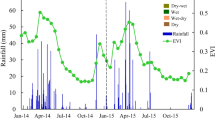Abstract
The long-term and continuous carbon fluxes of Changbaishan temperate mixed forest (CBS), Qianyanzhou subtropical evergreen coniferous forest (QYZ), Dinghushan subtropical evergreen mixed forest (DHS) and **shuangbana tropical rainforest (XSBN) have been measured with eddy covariance techniques. In 2003, different responses of carbon exchange to the environment appeared across the four ecosystems. At CBS, the carbon exchange was mainly determined by radiation and temperature. 0°C and 10°C were two important temperature thresholds; the former determined the length of the growing season and the latter affected the magnitude of carbon exchange. The maximum net ecosystem exchange (N EE) of CBS occurred in early summer because maximum ecosystem photosynthesis (G PP) occurred earlier than maximum ecosystem respiration (R e). During summer, QYZ experienced severe drought and N EE decreased significantly mainly as a result of the depression of G PP. At DHS and XSBN, N EE was higher in the drought season than the wet season, especially the conversion between carbon sink and source occurring during the transition season at XSBN. During the wet season, increased fog and humid weather resulted from the plentiful rainfall, the ecosystem G PP was dispressed. The Q 10 and annual respiration of XSBN were the highest among the four ecosystems, while the average daily respiration of CBS during the growing season was the highest. Annual N EE of CBS, QYZ, DHS and XSBN were 181.5, 360.9, 536.2 and −320.0 g·C·m−2·a−1, respectively. From CBS to DHS, the temperature and precipitation increased with the decrease in latitude. The ratio of N EE/R e increased with latitude, while R e/G PP, ecosystem light use efficiency (L UE), precipitation use efficiency and average daily G PP decreased gradually. However, XSBN usually escaped such latitude trend probably because of the influence of the south-west monsoon climate which does not affect the other ecosystems. Long-term measurement and more research were necessary to understand the adaptation of forest ecosystems to climate change and to evaluate the ecosystem carbon balance due to the complexity of structure and function of forest ecosystems.
Similar content being viewed by others
References
Global Carbon Project. Science Framework and Implementation. Earth System Science Partnership (IGBP, IHDP, WCRP, DIVERSITAS) Report No.1: Global Carbon Project Report No. 1 Canberra, 2003, 22–23
Dixon R K, Brown S, Houghton R A, et al. Carbon pools and flux of global forest ecosystem. Science, 1994, 263: 185–190
Malhi Y, Baldocch D D, Jarvis P G, The carbon balance of tropical, temperate and boreal forest. Plant, Cell and Environment, 1999, 22: 715–740
Valentini R, Matteucci G, Dolman A J, et al. Respiration as the main determinant of carbon balance in European forests. Nature, 2000, 404: 861–865
Barford C C, Wofsy S C, Goulden M L, et al. Factors controlling long-and short-term sequestration atmospheric CO2 in a mid-latitude forest. Science, 2001, 294: 1688–1691
Law B E, Falge E, Gu L, et al. Environmental controls over carbon dioxide and water vapor exchange of terrestrial vegetation. Agricultural and Forest Meteorology, 2002, 113: 97–120
Baldocchi D D, Falge E, Gu L H, et al. FLUXNET: A new tool to study the temporal and spatial variability of ecosystem-scale carbon dioxide, water vapor and energy flux densities. Bull Am Meteorol Soc, 2001, 82: 2415–2434
Mahli Y, Nobre A D, Grace J, et al. Carbon dioxide transfer over a Central Amazonian rain forest. Journal of Geophysical Research, 1998, 103: 31, 593–31, 513, 612
Voulitis G L, Filho N P, Hayashi M M S, et al. Seasonal variations in the net ecosystem CO2 exchange of a mature Amazonian transitional tropical forest. Functional Ecology, 2001, 15: 388–395
Loescher H W, Oberbauer S F, Gholz H L, et al. Environmental controls on net ecosystem-level carbon exchange and productivity in a Central American tropical wet forest. Global Change Biology, 2003, 9: 396–412
Greco S, Baldocchi D D. Seasonal variation of CO2 and water vapor exchange rates over a temperate deciduous forest. Global Change Biology, 1996, 2: 183–197
Aubinet M, Chermanne B, Vandenhaute M, et al. Long-term carbon dioxide exchange above a mixed forest in the Belgian Ardennes. Agriculture and Forest Meteorology, 2001, 108: 293–315
Baldocchi D D, Vogel C A, Hall B. Seasonal variation of carbon dioxide exchange rates above and below a boreal jack pine forest. Agriculture and Forest Meteorology, 1997, 83: 147–170
Griffis T J, Black T A, Morgenstern K, et al. Ecophysiological controls on the carbon balances of three southern boreal forests. Agriculture and Forest Meteorology, 2003, 117: 53–71
Yu G-R, Zhang L-M, Sun X M, et al. Advances in carbon flux observation and research in Asia. Sci China Ser D-Earth Sci, 2005, 48(Supp. I): 1–16
Baldocchi D D. Assessing the eddy covariance technique for evaluating carbon dioxide exchange rates of ecosystems: Past, present and future. Global Biology Change, 2003, 9: 479–492
Liu Y F, Song X, Yu G-R, et al. Seasonal variation of CO2 flux and its environmental factors in evergreen coniferous plantation. Sci China Ser D-Earth Sci, 2005, 48(Supp I): 123–133
Guan D X, Wu J B, Yu G-R, et al. Meteorological Control on CO2 flux above broad-leaved Korean pine forest in Changbai mountains. Sci China Ser D-Earth Sci, 2005, 48(Supp. I): 116–122
Yu G-R, Wen X F, Li Q K, et al. Seasonal patterns and environmental control of ecosystem respiration in subtropical and temperate forests in China. Sci China Ser D-Earth Sci, 2005, 48(Supp. I): 93–105
Zhou C Y, Zhou G Y, Zhang D Q, et al. CO2 efflux from different forest soils and impact factors in Dinghu Mountain, China. Sci China Ser D-Earth Sci, 2005, 48(Supp. I): 198–206
Sha L Q, Zhen Z, Tang J W, et al. Soil respiration in a tropical seasonal rain forest in **shuangbanna, SW China. Sci China Ser D-Earth Sci, 2005, 48(Supp. I): 189–197
Hollinger D Y, Kelliher F M, Byers J N, et al. Carbon dioxide exchange between an undisturbed old-growth temperate forest and the atmosphere. Ecology, 1994, 75: 134–150
Wilczak J M, Oncley S P, Stage S A. Sonic anemometer tilt correction algorithms. Bound-Lay Meteorology, 2001, 99: 127–150
Webb E K, Pearman G I, Leuning R. Correction of flux measurement for density effects due to heat and water vapour transfer. Q J Roy Meteor Soc, 1980, 106: 85–100
Falge E, Baldocchi D, Olson R, et al. Gap filling strategies for defensible annual sums of net ecosystem exchange. Agricultural and Forest Meteorology, 2001, 107, 43–69
Yan J H, Zhou G Y, Zhang D Q, et al. Spatial and temporal variation s of some hydrological factors in a climax forest ecosystem in the Dinghushan region. Acta Ecologica Sinica, 2003, 23(11): 2359–2366
Zhang K Y. The characteristics of south Yunan and preliminary analysis of its formation. Acta Meteorologica Sinica, 1966, 33: 210–230
Ruimy A, Jarvis P G, Baldocchi D D, et al. CO2 fluxes over plant canopies and solar radiation: A review. Advances in Ecological Research, 1995, 26: 1–81
Aubinet M, Heinesch B, Longdoz B. Estimation of the carbon sequestration by a heterogeneous forest: night flux corrections, heterogeneity of the site and inter-annual variability. Global Change Biology, 2002, 8: 1053–1071
Falge E, Baldocchi D, Tenhunen J, et al. Seasonality of ecosystem respiration and gross primary production as derived from FLUXNET measurements. Agriculture and Forest Meteorology, 2002, 113: 53–74
Wilson, K, Goldstein, A, Falge, E, et al., Energy balance closure at FLUXNET sites. Agricultural and Forest Meteorology, 2002, 223–243
Li Z Q, Yu G-R, Wen X F, et al. Energy balance closure at ChinaFLUX sites. Sci China Ser D-Earth Sci, 2005, 48(Supp. I): 51–62
Fan S-M, Wofsy S C, Bakwin P S, et al. Atmosphere-biosphere exchange of CO2 and O3 in the central Amazon forest. Journal of Geophysical Research, 1990, 25: 12851–16864
Grace J, Lloyd J, Mclntyre J, et al. Fluxes of carbon dioxide and water vapor over an undisturbed tropical rainforest in south-west Amazonia. Global Change Biology, 1995, 1: 1–12
Goulden M L, Miller S D, Da Rocha H R, et al. Diel and seasonal patterns of tropical forest CO2 exchange. Ecological Applications, 2004, 14(4, Supplement): S42–S54
Author information
Authors and Affiliations
Corresponding author
Rights and permissions
About this article
Cite this article
Zhang, L., Yu, G., Sun, X. et al. Seasonal variation of carbon exchange of typical forest ecosystems along the eastern forest transect in China. SCI CHINA SER D 49 (Suppl 2), 47–62 (2006). https://doi.org/10.1007/s11430-006-8047-2
Received:
Accepted:
Issue Date:
DOI: https://doi.org/10.1007/s11430-006-8047-2




